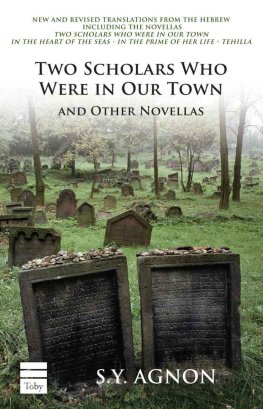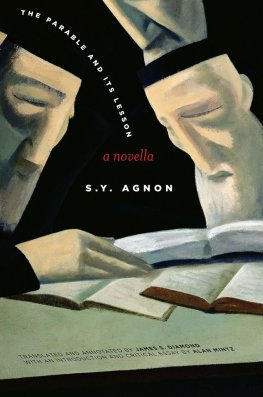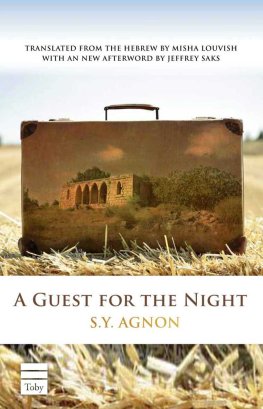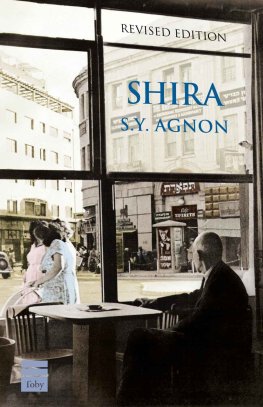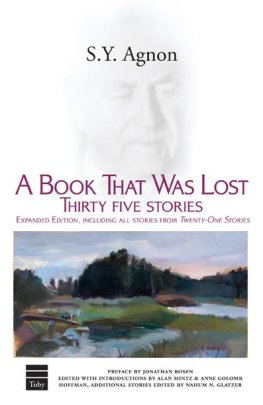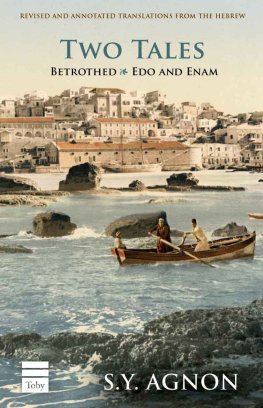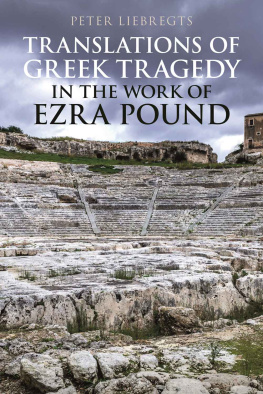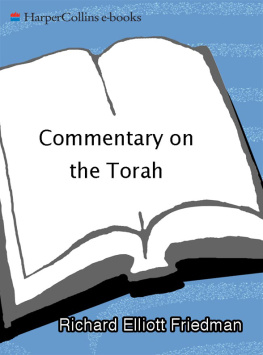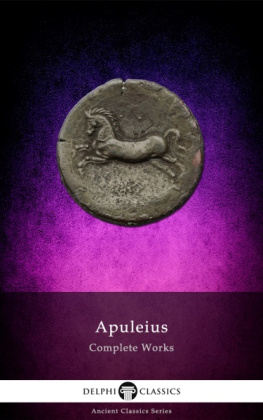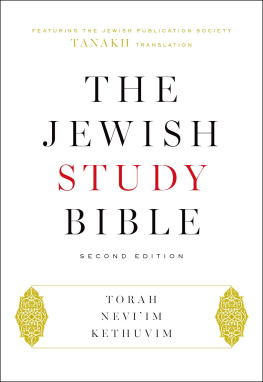S. Y. Agnon
Two Scholars Who Were in our Town and other Novellas
In The Story of the Seven Beggars, one of the Tales of the great Hassidic Rebbe Nachman of Breslov, a hunchback describes his mind as a little that contained a lot. Since he could hold some ten thousand people in his mind, along with all their desires and problems and needs, all of their trials and tribulations and triumphs, every element of their lives and nooks of their personalities, he presumed that he must be the little that contains a lot. But, Rebbe Nachman relates, everyone mocked him, saying that those people in his mind were nothing and in fact he was nothing as well.
The influence of Rebbe Nachman on Nobel laureate S.Y. Agnon should not be underestimated. Agnon saw in the Hassidic Master the starting point of what would become modern Jewish storytelling. Gershom Scholem remarked that if the Story of the Seven Beggars had not already been told by Rebbe Nachman, it could have become an Agnon story and would have taken on a perfectly Kafkaesque aura reminding us of that other Jewish surrealist writer, who together with Agnon and Nachman, were all shocked by the permeability, the loosened state of tradition (G. Scholem, S.Y. Agnon The Last Hebrew Classic? in On Jews and Judaism in Crisis).
And like the hunchback (and his literary creator, Rebbe Nachman), Agnon, too, possessed a little that contained a lot a phrase drawn from the world of Midrash and Kabbalah to describe the miraculous compression into finite space of more than seems possible that is, an imagination so vast that it contains multitudes, whole worlds of imaginative history emanating from and occupying the mind of finite, mortal man. This act of creativity, Godlike in its manner of bringing about creation through word and thought, is precisely the talent demonstrated in the literary world Agnon created.
The four novellas published here in new or revised translations are exemplars of the richness of that literary world created by Agnon, with webs of interconnected locales, legends and leitmotifs. The stories range over a roughly century-long period from the 1820s to the 1920s and are situated in Agnons ancestral Galician hometown of Buczacz (or its literary doppelganger, Szybusz), or in the Land of Israel of the Old Yishuv and in Jerusalem of the later British Mandate.
The following notes are meant to give background to these four novellas, as well as brief outlines to the major themes of each work and how each fits within Agnons canon. The annotated bibliography which closes this volume outlines the secondary literature and commentary written on these works in English.
Two Scholars Who Were in Our Town (Shnei Talmidei Hakhamim Shehayu BeIrenu) is being published here in English for the first time, in a debut translation by Paul Pinchas Bashan and Rhonna Weber Rogol, who have also prepared the annotations together with this volumes editor. The story tells of the epic clash between two Torah scholars, talmidei hakhamim, who according to the Talmudic phrase cannot abide each other in matters of halakhah leading to the death of one and the exile of the other (see Sotah 49a). First published in Hebrew in Luach Haaretz 5707 (Autumn 1956) and later collected in Agnons Samukh veNireh, the story is set over a period of roughly thirty years during the mid-nineteenth century in an unnamed Our Town, clearly meant to be Buczacz (as evidenced by the presence of one of Agnons own ancestors in a cameo role).
Narrating from a point three or four generations after the action, the narrator waxes nostalgic even elegiac for a time when Torah was beloved by Israel and the entire glory of a man was Torah, [when] our town was privileged to be counted among the most notable towns in the land on account of its scholars. And yet, as the plot unwinds and insults are traded in the Beit Midrash, the ancient Talmudic curse begins to work its dark power, leading to the tragic denouement. And here we see Agnons power as a tragedian on an almost Greek scale. With his typical irony at work, the narrator pines for an earlier, more ideal time which turns out to have been rife with flaws and tragic personalities of its own. This draws the reader to question was it always ever thus? Indeed, consider the Talmudic template on which Agnon sketches his modern tale of scholarly eros, ego, and clash the relationship between Rabbi Yohanan and Rabbi Shimon ben Lakish (especially as described in Bava Metzia 84a). After reading Agnons novella the reader might go back and study that primary text and see how he distilled the classical sources of the Beit Midrash into a modern midrashic matrix on which he composed his Nobel-winning literature.
In the Heart of the Seas (Bilvav Yamim), a tale of the journey to the Land of Israel by a group setting out from Buczacz, was Agnons first English translation published by Schocken Press, in 1947. While originally published in Hebrew in 1934 in a volume marking H.N. Bialiks sixtieth birthday, its earliest fragment was present in a small sketch sent for an unpublished 1926 festschrift in honor of the dying Franz Rosenzweig.
Written in the style of nineteenth-century Hassidic tales, the novellas weaving of folklore and aggada into modern literature helped cement Agnons reputation as the greatest Hebrew author of his time. The story was also singled out for praise for its idealization of the Love of Zion, at a time that the Yishuv was undergoing great struggles. Between 1933 and 1935 over one hundred and fifty thousand Jews had arrived in Palestine, more than all that had arrived in the years of the British Mandate up until that point. (Hitler was appointed Chancellor of Germany in January 1933, leading to a wave of German Jewish immigration). Agnons biographer Dan Laor shows that contemporary critics were especially mindful that this was the background on which the novella was composed. Agnons tale is a mlange of both a realistic as well as supernatural narrative of aliyah, and was interpreted as a cautionary statement to the immigrants and builders of the Jewish settlement in the Land of Israel: Zionism cannot only focus on the here-and-now, physical construction, but must recall the miraculous story that undergirds our work. It is a vision that emphasizes love of the land over labor, and the supernatural over nature. This may be precisely the reason Agnon chose to retroject himself into the story despite its setting one hundred years before its composition Rabbi Shmuel Yosef, the son of Rabbi Shalom Mordekhai ha-Levi of blessed memory, who was versed in the legends of the Land of Israel, those legends in which the name of the Holy One, blessed be He, is hallowed; and when he commenced lauding the Land, people could see as it were the name of the living God engraved on the tip of his tongue for that was how he envisioned the purpose of his artistic output.
An attentive reader will notice the dual frequencies on which the story is broadcast and the contrast between the natural travel tale of the group versus the miraculous voyage of Hananiah who floats along in the heart of the sea atop his magical kerchief. For the full messianic symbolism of this ersatz magic carpet see Agnons short story The Kerchief (in A Book That Was Lost, Toby Press). Lasks translation has been revised and newly annotated by this volumes editor.
In the Prime of Her Life (Bidmi Yameha) opens Agnons collection of love stories Al Kapot HaManul (At the Handles of the Lock; cf. Song of Songs 5:5), and is in many ways the type of psychological love story favored by European realism of the time. Yet, like Tehilla (which concludes this volume) and Agunot (Agnons signature story, from which he drew his penname), it is a disturbed and, in this case, disturbing love. One wherein two souls bound or chained together (the root of

